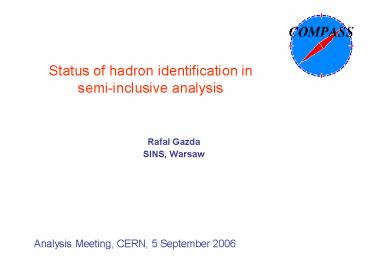Status of hadron identification in semi-inclusive analysis - PowerPoint PPT Presentation
Status of hadron identification in semi-inclusive analysis
Hadron identification for longitudinal data. Tuning LH cuts. RICH stability (badspills) ... Status of hadron identification in SIDIS. 3. RICH code for identification ... – PowerPoint PPT presentation
Title: Status of hadron identification in semi-inclusive analysis
1
Status of hadron identification in semi-inclusive
analysis
- Rafal Gazda
- SINS, Warsaw
Analysis Meeting, CERN, 5 September 2006
2
Motivation
Goal polarized strange sea quarks
distributions. One needs asymmetries of K and
K-.
Hadron identification for longitudinal data
Tuning LH cuts
RICH stability (badspills)
3
RICH code for identification
- Two RICH methods are available
- Chi2 and LH
- Two codes for LH are available for different
data(corespond to 04All-LH and 05All-LH) - The best results come from LH5 method, but part
of data has only LH4 - Only data with available LH5 was used
- (part of 2004 and 2002 data)
- For LH5 six likelihood values are available
- background
- Pion
- Kaon
- Proton
- Electron
- Muon
4
hadron identification
Standard cuts for SIDIS with Q2gt1GeV2
- Hadrons
- neither µB nor µ
- Zlast lt 33m
- zh(p)lt1
- pions
- LHmaxLH(p)
- Plt50 GeV
- LH(p)/...
- kaons
- LHmaxLH(K)
- Plt50 GeV
- LH(K)/...
5
Particle Identification
- Main problem is to distinguish pions from kaons
- Three cuts are tested on each kind of particle
- K
p - LH(K)/LH(p)
LH(p)/LH(K) - LH(K)/LH(bg)
LH(p)/LH(bg) - LH(K)/LH(2ndmax)
LH(p)/LH(2ndmax) - Cuts using LH of muon and electron were tried but
without any improvement (these particles are
partly removed with hadron cuts) - Use LH of proton brings no improvement either.
6
LH distributions
p
K
7
Tuning LH cuts...
- Tuning cuts on these parameters was done looking
at ?-gtpp- and F -gt KK- distributions. - Only events with three particles from primary
vertex were chosen µ and two oposite charged
hadrons (identified as p or K). - Ratio S/(SB) is calculated for each set of cuts
(each cut was changed from 1 to 1.3 with step
0.01)
8
Results of tuning
Example 2004, W40
very preliminary LH(p)/LH(K) gt
1 LH(p)/LH(bg) gt 1.08 LH(p)/LH(2ndmax)
gt 1
very preliminary LH(K)/LH(p) gt 1.09
LH(K)/LH(bg) gt
1.18 LH(K)/LH(2ndmax) gt 1.01
9
Conclusions
- Cuts on LH to identify p and K have been
optimized using sample of ? and F mesons. - Cuts are not finalized yet, work is in progress
- Also
- RICH stability check for longitudinal data has
been started
No conclusions yet...
PowerShow.com is a leading presentation sharing website. It has millions of presentations already uploaded and available with 1,000s more being uploaded by its users every day. Whatever your area of interest, here you’ll be able to find and view presentations you’ll love and possibly download. And, best of all, it is completely free and easy to use.
You might even have a presentation you’d like to share with others. If so, just upload it to PowerShow.com. We’ll convert it to an HTML5 slideshow that includes all the media types you’ve already added: audio, video, music, pictures, animations and transition effects. Then you can share it with your target audience as well as PowerShow.com’s millions of monthly visitors. And, again, it’s all free.
About the Developers
PowerShow.com is brought to you by CrystalGraphics, the award-winning developer and market-leading publisher of rich-media enhancement products for presentations. Our product offerings include millions of PowerPoint templates, diagrams, animated 3D characters and more.































